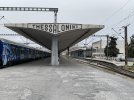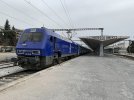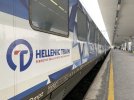Gag Halfrunt
Member
- Joined
- 23 Jul 2019
- Messages
- 730
The transport minister, Kostas Karamanlis, has resigned.
Norwich Thorpe, 1874? "Stop mail". "Mail left".Seems some similarity to the Amtrak accident in South Carolina a few years ago, with fully interlocked signalling seemingly installed (photo above) but out of use, and things being done by radio commands which are mishandled somehow along the line.
The ETR 470s are the only EMUs for long distance services in Greece. Athens-Thessaloniki services were formerly operated with class 520 DMUs, but after the line was electrified they were replaced with locomotive-hauled trains.
I think it departed Tuesday evening from Athens.
Could it have been a later train than 19.30 as the crash happened just before midnight and someone said its about 4 hours from Athens to Thessaloniki and the crash was quite a way before Thessaloniki. Maybe it was running late which might have some bearing on the reason if there had been problems with track/signalling. Just speculation of course.





[Giannis Antonoglou] and a handful of other survivors then went to help some of those injured and says ambulances and other emergency personnel didn’t turn up “for at least an hour”.
Literally no signalling. Instructions by radio/telephone. Someone must have made a mistake for this to happen, but the fact that it was allowed to operate in that condition is a failure of the state, no matter who made the fateful error
The accident site appears to be right next to the E75 motorway and the older Larissa-Thessaloniki main road.Is it fairly remote?
Even if the local investigation does just that, the European Rail Agency's safety branch also has overview rights. They wrote a pretty damning review (in polite euro-speak) of the Santiago di Compostela accident, critiquing the local Spanish report.Dreadful tragedy.
Hope the true cause is properly identified and that there are funds to correct the problems - such as with the signalling situation.
[and that they don't find some convenient scapegoat to blame]
Hellenic Train's services will be cancelled and after 12 noon no train service will be operated.
The last services that will operated are the following:
1213 (Αirport-Piraeus), departure time 11:07
1313 (Kiato- Piraeus), departure time 10:59
1214 (Piraeus- Airport), departure time 10:45
1312 (Piraeus - Kiato), departure time 11:15
C10E (Kiato- Patra), departure time 12:05.
12300 (Rio- Ag. Andreas), departure time 11:08
12301 (Ag. Andreas- Rio), departure time 11:30
12350(Αgios Andreas- Kaminia), departure time 11:32
In my lifetime, I know of a signaller talking a train past a signal at danger due to a signalling failure. Unfortunately the signaller was talking to the wrong driver, and due to the way the points at the junction happened to be set, when the train pulled away, it ended up going up the down line. This line is not signalled for bidirectional running, hence there were no further signals to stop the train…Norwich Thorpe, 1874? "Stop mail". "Mail left".
I thought of that as well, being a local. R.I.P to those lost.Norwich Thorpe, 1874? "Stop mail". "Mail left".
If you look at the wider angle photos, it's clear that the far ends of both trains which remained on the track are both on the same track. Trains in Greece run on the right so the passenger train was running on the wrong line.There seems little or no information on the practical side, such as why on a mainstream double track electrified route were trains operating two way on one track. What signalling arrangements were actually in use? Which one was running Wrong Line? Was it in actual fact a head-on, or did one derail into the path of the other? And such like.
In contrast, disappointing and extensive media coverage of what I think they term the "human story" side of things. Multiple mention of the train carrying many students. However as I understand it the formation was locomotive (no concern reported for the two drivers/crew involved), then the first class coaches which were at the north end, and thus very unlikely that students were in the vehicles which have taken the brunt of the casualties.
Many times on heritage lines I've seen a signaller give permission for a driver to pass a red signal, simply because he couldn't get it to clear. No investigation of anything relating to why it wouldn't clear. At least twice it was due to interlocking as a conflicting route was set and once due to a loco being in the platform.but also admitted letting the passenger train SPAD
When I heard it was a head on collision, I made the assumption that this would have been in a single track section, however I was surprised that this has occurred in one of the newly built double sections - beyond all comprehension if they've just spend billions upgrading to a two track railway then only use one track. We travelled on this last summer from Thess down to Athens, it was loco hauled then too, I would say it's noticeably faster due to the upgrades, but worrying if the most basic of safety systems aren't being used.
Many times on heritage lines I've seen a signaller give permission for a driver to pass a red signal, simply because he couldn't get it to clear. No investigation of anything relating to why it wouldn't clear. At least twice it was due to interlocking as a conflicting route was set and once due to a loco being in the platform.
When systems are so unreliable, such as what I hear about Greece, it is dangerous to let people slip into the mindset that their first thought is that the safety system has failed, rather than the safety system is working and stopping you doing what you want to do for a legitimate reason.
This is a valid reason as to why you pass a signal at danger, but obviously having a conflicting route set makes that outrageous. The same with the train in section.Many times on heritage lines I've seen a signaller give permission for a driver to pass a red signal, simply because he couldn't get it to clear. No investigation of anything relating to why it wouldn't clear. At least twice it was due to interlocking as a conflicting route was set and once due to a loco being in the platform.
When systems are so unreliable, such as what I hear about Greece, it is dangerous to let people slip into the mindset that their first thought is that the safety system has failed, rather than the safety system is working and stopping you doing what you want to do for a legitimate reason.
Absolutely, but I'm a mainline driver and have had a signaller say to me before "it's likely I'll call you back and you'll be passing it at danger, but we need to run some checks first"This is a valid reason as to why you pass a signal at danger, but obviously having a conflicting route set makes that outrageous. The same with the train in section.
In the same timeframe I remember travelling on a somewhat secondary (but electrified) route in Italy, sitting at the front of an old single-car unit and watching as we speeding past stations which appeared to have hand-thrown mainline switches and very little or no signals. It was much the same when I travelled around the Peloponnese (Greece) metre-gauge network in 2003 - which extended into Athens back then - eventually they got EU money to put in proper signalling, only to later mostly abandon the Peloponnese network in the financial crisis...I travelled around Greece in the 80's and there was a marked lack of signalling then. We would be bowling along a single line and sometimes diverted into a loop.
The very unfortunate irony there was that the signal system was temporarily out-of-use during upgrading work to support PTC (Positive Train Control), the primary purpose of which is to prevent collisions... (if I remember correctly, the cause of the collision was a mainline switch left open to a siding by a freight train crew and not or incorrectly reported to the controlling dispatcher).Seems some similarity to the Amtrak accident in South Carolina a few years ago, with fully interlocked signalling seemingly installed (photo above) but out of use, and things being done by radio commands which are mishandled somehow along the line.
I wonder if that's the case in Greece. I'm pretty sure the line is fully signalled conventionally. Some former colleagues at BR's Reading signal drawing office were employed for years on this work soon after that organisation's privatisation, in ADtranz days I think. Greece never had any legacy form of train protection, so more recently elected to equip the entire network with ETCS level 1, which retains all the conventional signalling and provides a fully protective ATP overlay using standard ETCS components. It's possible parts of the interlocking and control systems may have been isolated to allow such work to be carried out. Alternatively, the need for manual block methods may have been because of equipment failure, or trackwork closing a line where there's no bi-di facility on the open line.The very unfortunate irony there was that the signal system was temporarily out-of-use during upgrading work to support PTC (Positive Train Control), the primary purpose of which is to prevent collisions... (if I remember correctly, the cause of the collision was a mainline switch left open to a siding by a freight train crew and not or incorrectly reported to the controlling dispatcher).
Heritage line signallers on anything other than a single line with one train, I wouldn't trust for a few reasons.
Even if they are an ex signaller, they could be well out of practice.
Even if they are a current signaller, they could well be from somewhere that has no complexity to it and have never had to practice the required skills.
Who's checking their competencies and ensuring their knowledge hasn't lapsed because they haven't done something in years?
You don't know what you don't know as they say.
